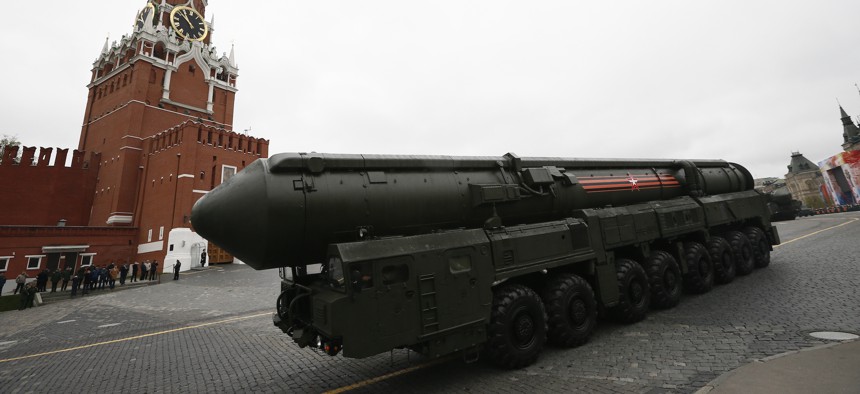
In this Tuesday, May 9, 2017 file photo, Russian Topol M intercontinental ballistic missile launcher rolls along Red Square in Moscow. AP Photo/Alexander Zemlianichenko, File
A No-Cost, No-Brainer of a Nuclear Deal
Extending New START would be an easy win out of the Trump-Putin summit.
Most of the Western security establishment is dreading next week’s meeting between President Donald Trump and Russian President Vladimir Putin. There is a whole lot that could go wrong. But there is one thing that could go right. The two could agree to keep a brake on the nuclear arms race by extending an existing arms control agreement for another five years. In normal times, it would be a no-brainer.
The New START Treaty will expire in 2021. If it does, both nations could bust through the ceiling the accord places on each side’s long-range nuclear forces — the missiles and bombers that can span oceans to deliver nuclear bombs in as little as 30 minutes after launch. For the first time since President Richard Nixon negotiated the SALT Treaty in 1972, there would be no limit to the number or types of strategic weapons Russia and the United States deploy.
Worse, Russia and the United States would lose all inspections, tracking and verification of these arsenals, which account for over 92 percent of all the nuclear weapons in the world. This would introduce major uncertainties into a relationship already strained with mistrust and suspicion.
U.S. Ambassador to Russia Jon Huntsman says arms control “will be prominent on the agenda,” and that the two sides “will have to make a decision on whether or not there [will] be a re-upping for five years.” Huntsman notes, “We have passed a very important milestone last Feb. 5 where both the United States and Russia were to meet the internal goals of no more than 1,550 deployed strategic warheads. And both met that target, and both have done the accounting to meet that.” Russia is fully compliant with the treaty.
Related: Don’t Give Russia the Gift of Extending New START
Related: At Trump-Putin Meeting, Start with New START
Related: Putin Just Gave Trump the Arms Race He Sought
Extending the pact is easy. “It can be done by agreement between Trump and Putin,” says former State Department arms control official Alexandra Bell, now with the Center for Arms Control and Non-Proliferation. “The treaty doesn’t need to be re-ratified.” When the U.S. Senate approved the agreement in 2010, says Bell, it did so with the knowledge that a future executive could independently choose to extend it. “We absolutely should extend New START,” she says.
Putin seems willing. He offered to do so in his first phone call with Trump right after his inauguration in 2017. But Trump was unprepared. Aides told reporters that he had to put Putin on hold to ask them what New START was. He then launched into a screed against the pact, claiming it was one of many bad deals negotiated by President Obama and favored Russia. Putin again voiced support for extension in a March interview, saying his country was “ready to continue this dialogue.”
The main obstacle to extending the accord seems to be Trump’s hatred of all things Obama and the opposition of National Security Advisor John Bolton, an ideological foe of any restraints on U.S. military power. America’s military leadership, however, is comfortable with the treaty and — unlike Bolton — strongly supported it during the 2010 ratification fight. A study by the Joint Chiefs in 2013 even concluded that the U.S. could unilaterally cut to about 1,000 strategic weapons and fulfill all its military missions — no matter what Russia did.
Equally important to the limits are the irreplaceable insight into Russian nuclear forces offered by the treaty’s on-the-ground inspections. They would end if the treaty dies. “Without New START, the U.S. would be without a clear eye into the Russian strategic nuclear infrastructure for the first time in decades,” Bell told me. “We want that kind of insight so we can plan our nuclear forces accordingly.”
It is not just the American military that would lose out if the treaty dies. Our European NATO allies benefit from U.S.-Russian strategic transparency, too. This April, a commission of high-level government officials and experts from across Europe, including Russia, released a joint statement urging an “immediate extension of the New START Treaty,” citing the “significant security advantages” provided by “the treaty’s verification measures (including data exchanges, notifications and inspections).”
“It’s the one bright spot in the U.S.-Russian strategic stability right now,” said Bell. “We have various problems with conventional arms control and the Russian violation of the Intermediate Nuclear Forces Treaty. New START is working and we should be thankful for that.”
New START implementation has been an unequivocal success story. Every year since 2011, the U.S. and Russia have completed their maximum-allowed annual inspections like clockwork, seemingly unaffected by significant tensions that exist elsewhere in the relationship. These inspections, aside from their obvious material utility, encourage a sort of transparency and predictability that is altogether invaluable in promoting strategic stability.
Trump bills himself as a great deal-maker. Next week, he has an opportunity to earn that self-proclaimed reputation. With little effort and no cost, Trump can secure five more years of verified limits on Russian forces. It would be the best deal of his presidency so far.


